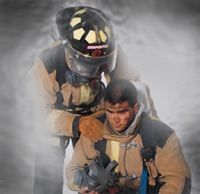Fires often emit harmful gases such as carbon monoxide (CO) and hydrogen cyanide, usually in the form of soot or smoke. If inhaled in huge amount, these by-products can cause significant injury to the upper airway.
Inhaled injuries occur when a person has inhaled heated gases such as by-products of burned materials. Smoke inhalation is the leading cause of mortality related to fires rather than burns. It is estimated that 2 out of 10 people who suffer from burns will have some degree of inhalation injuries. Inhalation injuries can lead to the impairment of the body’s normal gas exchange and even respiratory failure thus are potentially life threatening.
Understanding Inhalation Injuries
The respiratory system is a crucial part of the human body that plays an essential role in maintaining proper oxygenation of the blood, without oxygen, a person can die in an instant.
The respiratory system starts with the upper airways, from the nose going down to the very fine blood vessels in the lungs where gas exchange occurs. When a person inhales heated gases, the mucosal barrier gets burned leading to inflammation, sloughing of tissues and obstruction of airway. Irritating gases and chemicals can also trigger bronchospasm or the uncontrolled contraction of lung tissues that makes exhalation difficult and noisy. 
Signs and Symptoms
Recognizing inhalation injuries is primarily based on physical assessment. Victims of smoke inhalation often present symptoms that include:
- Coughing
- Hoarseness
- Shortness of breath
- Noisy breathing
- Bluish discoloration of lips or skin
- Black or grey spittle
- Fluid in the lungs
Some victims may show burns around and inside the mouth and nose, swollen throat and singed nasal hairs. In severe cases, the person may become unconscious and may even stop breathing. However, it is also possible for victims to show no signs of respiratory distress. Laboratory tests such as X-ray can help rule out inhalation injuries.
First Aid For Inhalation Injuries
As in any emergency situation, your top priority is to ensure your personal safety. Immediately survey the scene and check for any potential danger or risks. Call 911 or your local emergency services.
- Check airway, breathing and circulation (ABC’s). Open the airway and monitor breathing.
- Make sure the victim is breathing normally. Assist the casualty in a position of comfort – semi-sitting or upright position. Loosen clothing, including belt and tie.
- If breathing is ineffective or if it stops, provide rescue breathing.
- Check for pulse and be ready to provide CPR, in case pulse stops.
- Monitor for possible shock. Keep casualty warm.
- Provide reassurance while waiting for medical assistance to arrive.
To learn more about first aid for inhalations and other breathing emergencies enrol in workplace approved first aid training with a credible provider. A list of all of our providers is located on our “locations” page. In these classes you will learn, via “hands on training”, how to manage these and many other emergencies.
